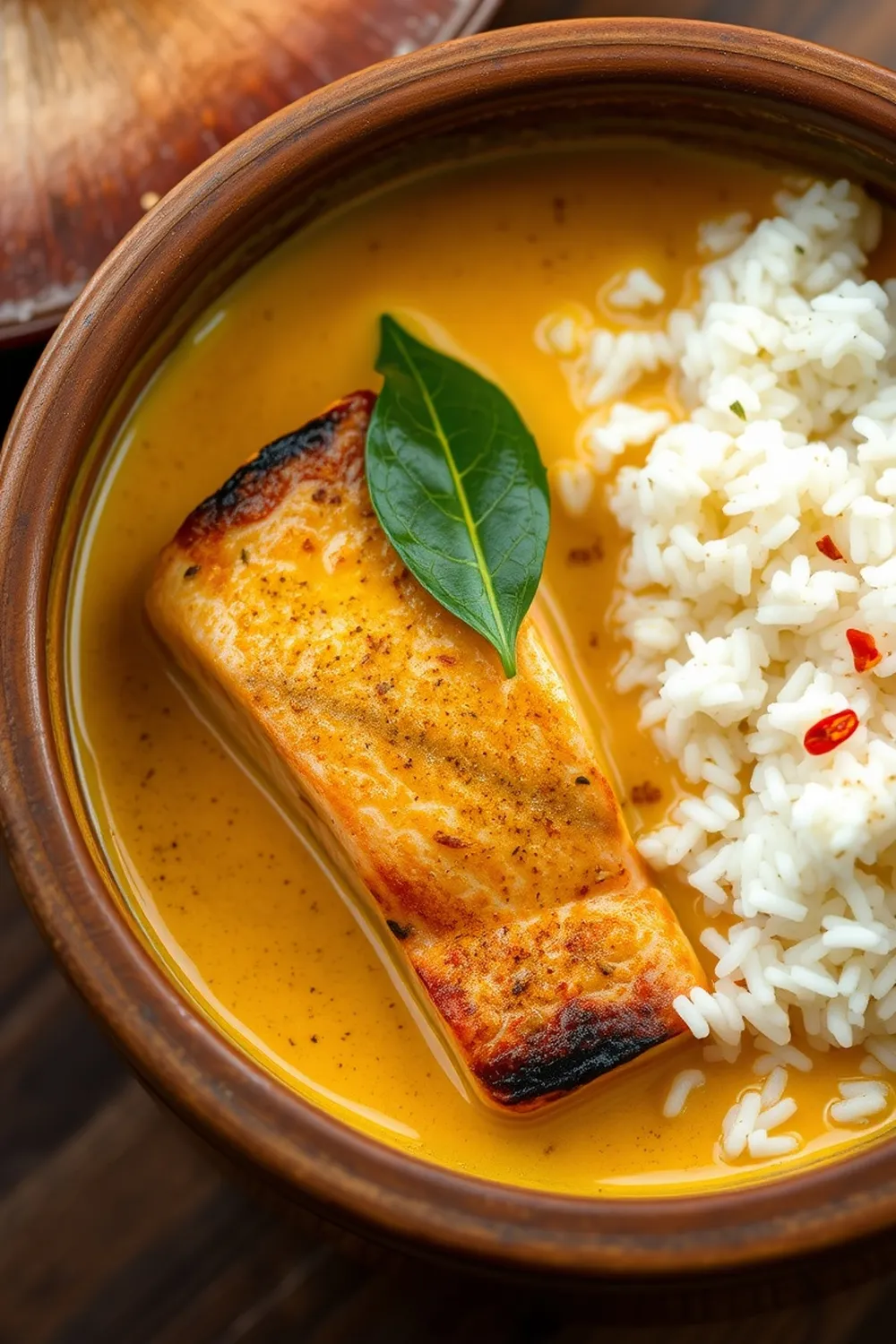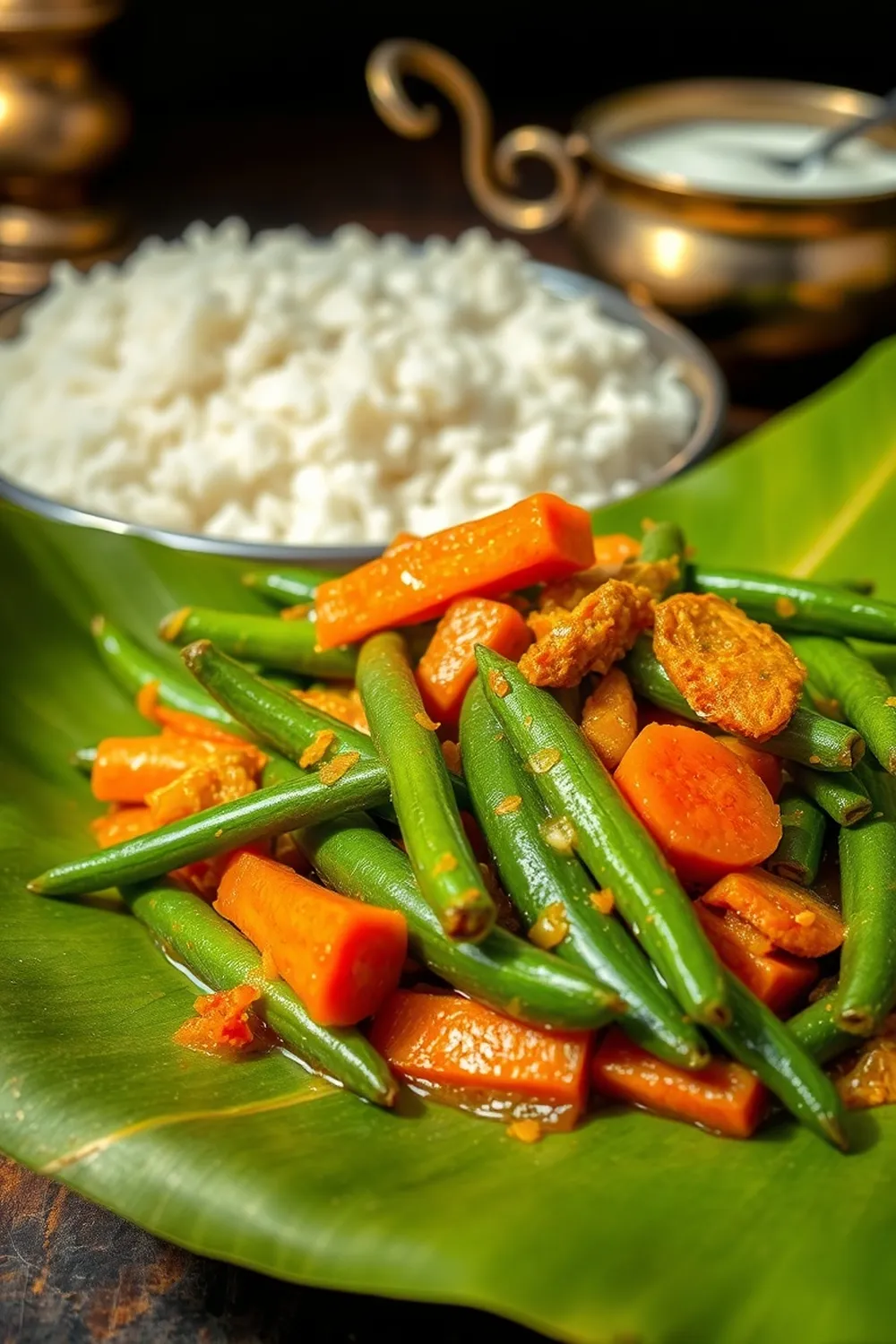- Prepare coconut milk by blending grated coconut with 1 cup water. Strain to extract thick milk. Add 1 glass of water to the residue, blend again, and strain for thin milk.
- Heat coconut oil in an earthen pot. Add mustard and fenugreek seeds; let them splutter.
- Sauté minced shallots/onion and green chilies until softened.
- Stir in turmeric and red chili powders; cook briefly to remove raw aroma.
- Add chopped tomatoes and cook until mushy and oil separates.
- Pour thin coconut milk and salt into the pot. Bring to a boil.
- Gently add fish pieces and simmer until cooked through.
- Mix in thick coconut milk. Remove from heat immediately to prevent curdling.
- Garnish with curry leaves. Let the curry rest to enhance flavors before serving.
- Serve warm with steamed rice or traditional pathiris.
- Calories:350 kcal25%
- Energy:1464 kJ22%
- Protein:15 g28%
- Carbohydrates:20 mg40%
- Sugar:5 mg8%
- Salt:800 g25%
- Fat:25 g20%
Last Updated on 6 months ago by Neha Deshmukh
Kerala Fish Curry Recipe – Coconut Milk & Spiced Salmon
Introduction
Oh, Kerala Fish Curry. Just the aroma transports me straight back to my grandmother’s kitchen! This isn’t just a recipe; it’s a hug in a bowl, a taste of home, and a vibrant celebration of Kerala’s coastal flavours. I first made this myself when I was craving a little piece of my childhood, and honestly, it’s been a family favourite ever since. It’s a little bit of effort, but trust me – the result is so worth it. Let’s dive in, shall we?
Why You’ll Love This Recipe
This Kerala Fish Curry is special for so many reasons. The creamy coconut milk beautifully balances the warmth of the spices, and the fish just melts in your mouth. It’s a flavour explosion that’s both comforting and exciting. Plus, it’s a fantastic way to experience the authentic tastes of South India. It’s a dish that’s perfect for a weeknight dinner or a special occasion.
Ingredients
Here’s what you’ll need to create this magic:
- 1 cup grated coconut
- 1 tbsp coconut oil
- 0.5 tsp mustard seeds
- 0.5 tsp fenugreek seeds
- 5-6 shallots or 1 small onion (minced)
- 3 green chillies (slit)
- 0.25 tsp turmeric powder
- 0.5 tsp red chilli powder
- 2 tomatoes (chopped)
- 300 gm thick fish (salmon) – you can also use cod, kingfish, or pomfret
- Salt to taste
- Curry leaves (for garnish)
- Approximately 1.5 – 2 cups water (for coconut milk)
Ingredient Notes
Let’s talk ingredients! Using fresh, good-quality ingredients really makes a difference.
- Coconut: Freshly grated coconut is key for that authentic flavour. To make the coconut milk, blend the grated coconut with about 1 cup of warm water. Strain it well – you’ll need both the thick and thin milk for this recipe. Don’t discard the residue after the first extraction! Add another glass of water, blend again, and strain for a second, lighter coconut milk.
- Mustard & Fenugreek Seeds: These little seeds are flavour powerhouses! They add a lovely nutty aroma and depth to the curry. Don’t skip them!
- Fish: Traditionally, Kerala fish curries use fish like kingfish (seer fish), pomfret, or sardines. Salmon works beautifully too, and is readily available. Choose a firm, thick fish that won’t fall apart during cooking.
- Spice Level: Feel free to adjust the amount of red chilli powder to your liking. I usually go with 0.5 tsp for a medium spice level.
Step-By-Step Instructions
Alright, let’s get cooking!
- First, let’s make the coconut milk. Blend the grated coconut with 1 cup of water and strain. Repeat with another cup of water to extract both thick and thin coconut milk. Set aside.
- Heat the coconut oil in an earthen pot (if you have one – more on that later!). If not, a regular heavy-bottomed pot works just fine.
- Add the mustard and fenugreek seeds. Let them splutter and dance in the oil – this releases their amazing flavour.
- Now, add the minced shallots (or onion) and slit green chillies. Sauté until they soften and turn translucent.
- Stir in the turmeric and red chilli powders. Cook for just a minute or two, until the raw aroma disappears. You don’t want to burn the spices!
- Add the chopped tomatoes and cook until they become mushy and the oil starts to separate from the mixture. This is a sign that the base is coming together nicely.
- Pour in the thin coconut milk and add salt to taste. Bring the mixture to a gentle boil.
- Gently add the fish pieces to the pot. Simmer until the fish is cooked through – this usually takes about 5-7 minutes, depending on the thickness of the fish.
- Finally, pour in the thick coconut milk. Immediately remove the pot from the heat. This prevents the coconut milk from curdling.
- Garnish with fresh curry leaves. Let the curry rest for at least 10-15 minutes to allow the flavours to meld together. Trust me, this resting period makes a huge difference!
Expert Tips
- Earthen Pot Magic: Cooking in an earthen pot (like a chettikallu) adds a unique earthy flavour to the curry. It also helps to distribute heat evenly.
- Don’t Overcook the Fish: Overcooked fish is dry and rubbery. Keep a close eye on it and remove it from the heat as soon as it’s cooked through.
- Taste as You Go: Adjust the salt and spice levels to your preference.
Variations
- Vegan Adaptation: Swap the fish for jackfruit or banana blossom! These have a lovely texture that works beautifully in this curry.
- Gluten-Free: This recipe is naturally gluten-free, so you can enjoy it without any worries.
- Spice Level Adjustment: For a milder curry, reduce the amount of red chilli powder. For a spicier kick, add a pinch of cayenne pepper. My friend, Priya, loves to add a finely chopped bird’s eye chilli for extra heat!
- Festival Adaptations: This curry is often made during Onam and Vishu, Kerala’s harvest festivals. It’s a symbol of abundance and prosperity.
Serving Suggestions
Serve this Kerala Fish Curry warm with fluffy steamed rice or traditional pathiris (Kerala rice pancakes). A side of thoran (stir-fried vegetables) and a dollop of yogurt complete the meal perfectly.
Storage Instructions
Leftovers can be stored in an airtight container in the refrigerator for up to 2 days. The flavours actually develop even more overnight! Reheat gently on the stovetop.
FAQs
What type of fish is traditionally used in Kerala Fish Curry?
Traditionally, you’ll find kingfish (seer fish), pomfret, or sardines used in Kerala Fish Curry. However, salmon, cod, or any firm white fish work well too.
Can I use store-bought coconut milk instead of making it from scratch?
Yes, you can! If you’re short on time, store-bought coconut milk is a convenient option. Look for full-fat coconut milk for the best flavour and creaminess.
How can I adjust the spice level of this curry?
Reduce the amount of red chilli powder for a milder curry, or add a pinch of cayenne pepper for extra heat.
What is the significance of cooking in an earthen pot?
Cooking in an earthen pot imparts a unique earthy flavour and helps distribute heat evenly. It’s a traditional method that adds a special touch to the curry.
How long does this curry keep in the refrigerator?
This curry will keep in the refrigerator for up to 2 days in an airtight container.
Neha Deshmukh
Neha holds a B.A. in History with a focus on Indian and world history, including ancient, medieval, and modern periods. At RecipesOfIndia.org — the world’s largest database of Indian recipes — she combines her love for food and history by exploring how India’s past has shaped its culinary traditions.








